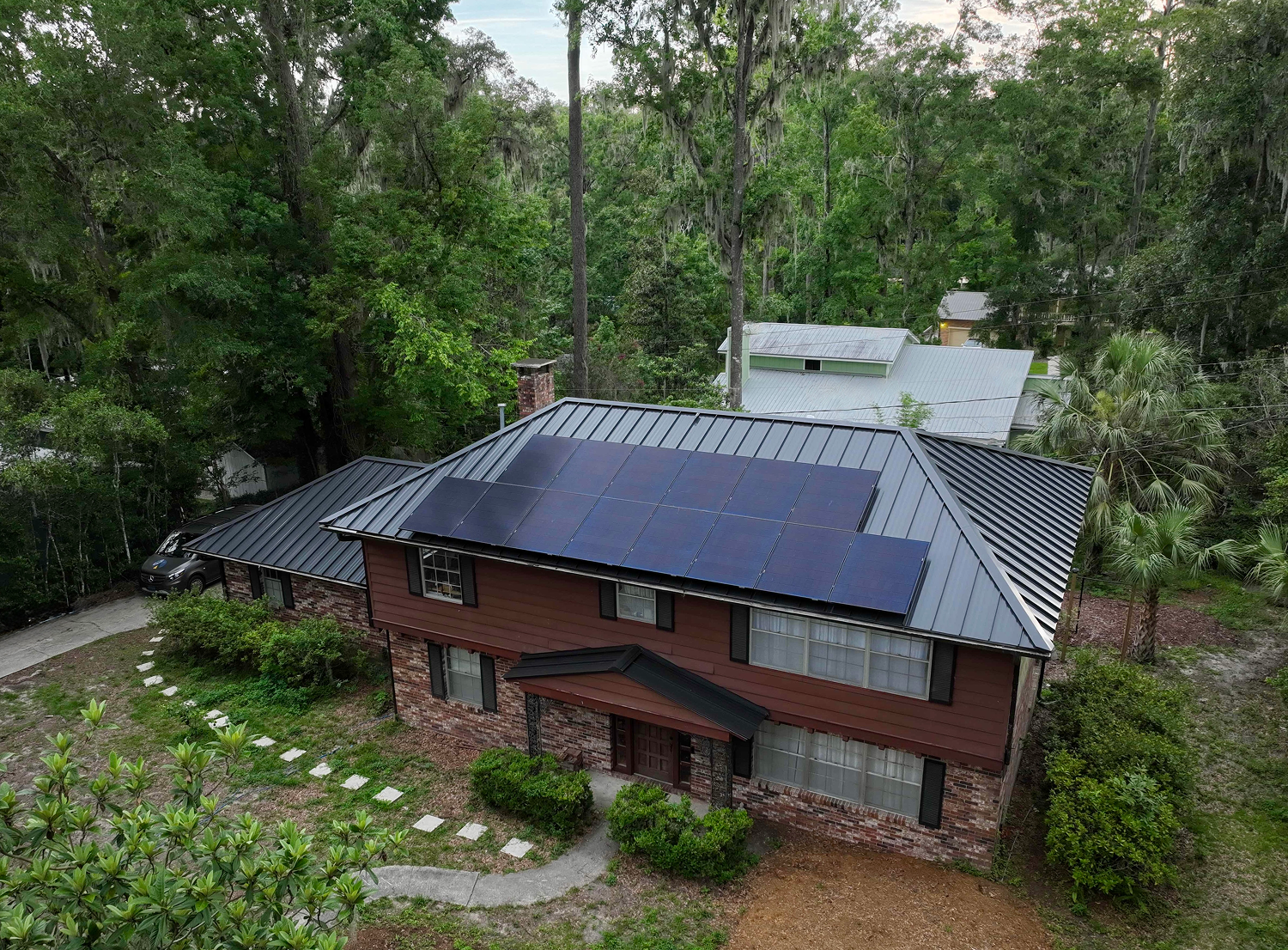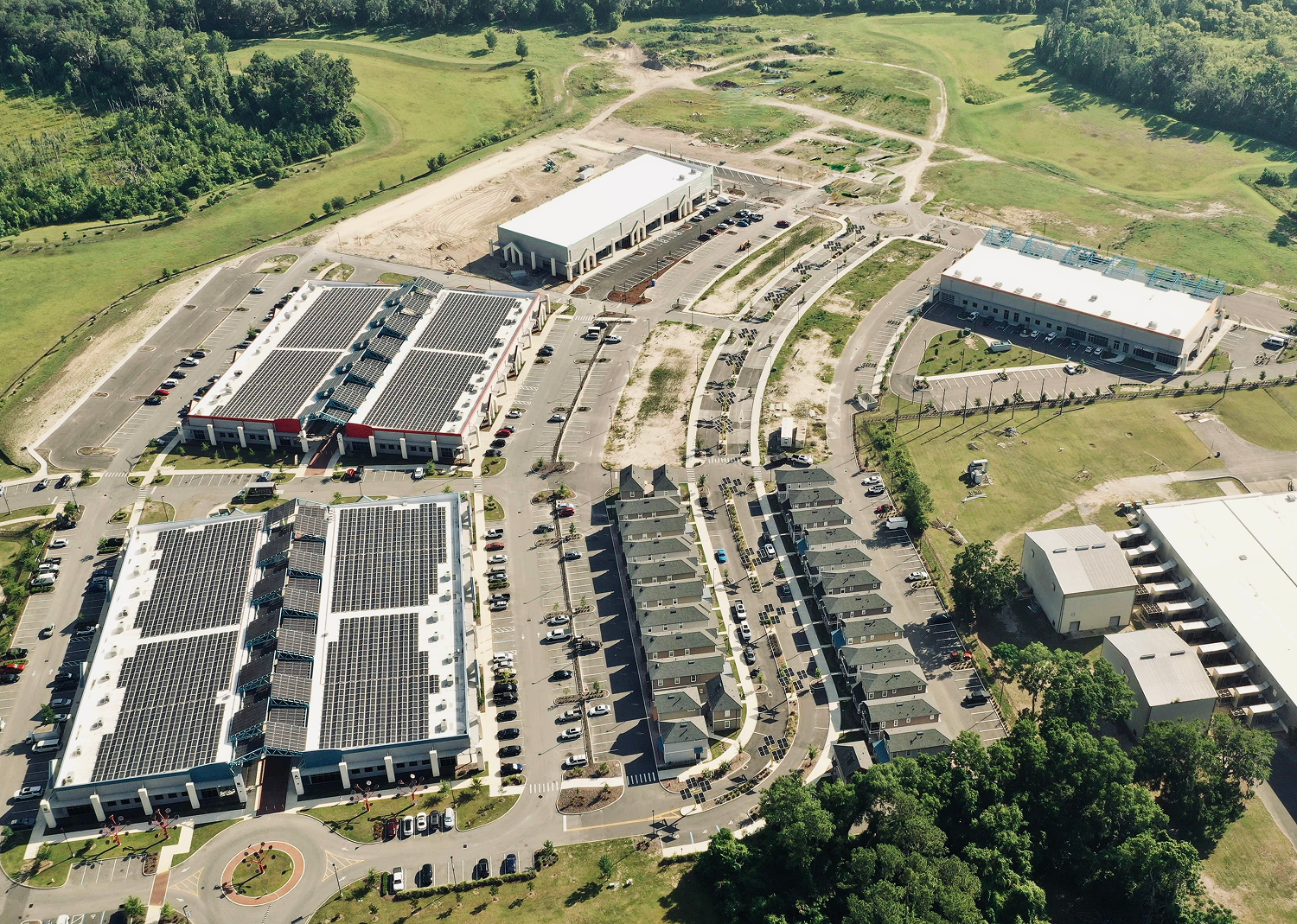When your rooftop panels are cranking out more electricity than your family can use, a home battery steps in as your personal power bank. It stores the extra solar energy for later and automatically takes over during a blackout, keeping lights, Wi-Fi, and even the fridge running while the neighborhood sits in the dark—and it can shave dollars off the utility bill on ordinary days, too.
This guide breaks it all down: how the technology works, pros and cons, sizing math, current pricing, top products, available incentives, and the installation process here in Florida. By the end, you’ll know exactly what to expect and whether a solar battery backup is the right investment for your home—all delivered in plain language, not electrical jargon.
How Solar Battery Backup Works in a Grid-Tied Home
A grid-tied battery backup adds a few smart pieces to the solar puzzle you already know: a hybrid inverter that can both export and charge, a lithium battery pack, and an automatic transfer device (often called a “gateway”). During sunny hours the system prioritizes household loads first; any surplus charges the battery until it’s full, after which excess power flows outward through your net-metering meter. After dusk or during high-rate windows the process reverses—the battery discharges, saving you from buying pricey utility power. If the grid suddenly fails, the gateway islands the home in under a second, energizes a designated backup panel, and keeps essentials humming without any manual fuss, all while meeting NEC rapid-shutdown and UL 9540A fire-safety rules.
Components of a Solar Battery Backup System
- Solar PV array
- Hybrid inverter or separate charge controller
- Lithium battery modules with integrated BMS
- Automatic transfer switch / backup gateway
- Monitoring app or web portal
- Optional: smart breaker panels like Span for flexible load control.
Charge/Discharge Cycle and Energy Flow Scenarios
Daytime: solar → home → battery → grid
Peak utility rates: battery → home
Overnight: battery → home until reserve set-point, then grid
Outage: battery + solar → critical-load panel.
Backup vs Off-Grid: Understanding the Difference
Backup systems assume the grid exists most of the time and size batteries for hours, not days. Off-grid homes eliminate the utility entirely, requiring larger arrays, expanded storage, and often a generator—tripling costs and tightening permitting rules. For most Florida homeowners, a grid-tied backup delivers the sweet spot of resiliency and affordability.
Key Benefits of Adding Battery Storage to Your Solar System
Pairing your panels with a battery turns a good solar array into a full-blown home-energy system. Beyond simply keeping the lights on, storage lets you time-shift sunshine, protect your wallet from peak rates, and even earn side income from emerging utility programs—all while shrinking your carbon footprint a bit further. Here are the four advantages homeowners notice first.
Protection During Power Outages and Extreme Weather
A charged battery kicks in instantly when the grid drops, running crucial circuits like refrigeration, internet, and lighting. In hurricane-prone Florida, one 13 kWh unit keeps essentials alive for 8–12 hours; stack two and you can ride out a full-day blackout with air-conditioning.
Maximizing Self-Consumption and Reducing Peak Charges
Time-of-use plans often spike after 4 p.m. Storing midday surplus and discharging during the expensive window can sidestep $0.28 ⁄ kWh rates, trimming annual bills by $300 or more on a typical 10 kWh pack.
Supporting Grid Services and Future Time-of-Use Rates
Utilities are piloting “virtual power plant” programs that pay owners to export stored energy on command. Joining one can shave a few hundred dollars off the payback period while helping stabilize the local grid.
Environmental Impact: Lowering Carbon Footprint Further
Using stored solar instead of evening peaker-plant power avoids roughly 1 lb CO₂ per kWh. That’s the emissions equivalent of planting about 15 trees each year for a single 10 kWh battery.
Types of Home Solar Batteries and Storage Architectures
Not every battery is built—or wired—the same. Chemistry, wiring topology, and backup strategy each affect cost, safety, and how long your house can run when the grid quits. The quick primers below will help you match the right tech to your goals.
Lithium-Ion Chemistry Variants (NMC vs LFP)
- NMC (Nickel-Manganese-Cobalt) packs the most watt-hours per square foot, so it rules tight indoor spaces.
- LFP (Lithium-Iron-Phosphate) trades a bit of energy density for longer cycle life (≥6,000 cycles) and lower fire risk—why many 2025 residential models, including Powerwall 3, now use LFP.
- Either chemistry pairs well with a solar battery backup for home; the choice comes down to footprint versus durability.
AC-Coupled vs DC-Coupled Systems: Pros and Cons
| Feature | AC-Coupled | DC-Coupled |
|---|---|---|
| Retrofit ease | ⭐⭐⭐⭐ | ⭐⭐ |
| Round-trip efficiency | ~88 % | ~94 % |
| Component count | Extra inverter required | One hybrid inverter |
| Best for | Adding to existing solar | New builds, maximum efficiency |
Whole-Home vs Partial-Home Backup Strategies
- Partial backup feeds a sub-panel with essentials (fridge, lights, Wi-Fi); keeps battery size and wiring costs low.
- Whole-home backup energizes every circuit, great for HVAC or well pumps but often needs multiple batteries and possibly a service-rated transfer switch.
Emerging Technologies: Sodium-Ion, Flow, Second-Life Batteries
Sodium-ion promises lower cost and better cold tolerance, while zinc-bromine or vanadium flow batteries offer unlimited cycle life for large estates. Second-life EV packs are being piloted for garage installations. All are intriguing, but mass-market availability is expected post-2026.
Sizing Your Solar Battery Backup: How Much Capacity Do You Really Need?
Grab-and-go battery bundles are tempting, but a one-size pack can leave you short during a storm—or wasting money on unused capacity. Proper sizing starts with an honest audit of what you’ll power, for how long, and how quickly those appliances demand it. Follow the steps below before placing an order.
Estimating Critical vs Whole-Home Loads
List every circuit you want alive when the grid fails. Essentials (fridge, modem, a few lights) usually add up to 3–5 kWh per day; whole-home ambitions with HVAC or well pumps can exceed 25 kWh. Use a simple worksheet:
| Device | Watts | Hours/day | Daily kWh |
|---|---|---|---|
| Refrigerator | 150 | 10 | 1.5 |
| Wi-Fi & lights | 200 | 6 | 1.2 |
| Total | 2.7 |
Calculating Daily kWh Needs and Peak kW Output
Add the daily kWh column for energy, then note the highest simultaneous wattage for power. Formula: kWh = Σ(W × h) / 1000, peak power kW = max W / 1000. Compare the latter to a battery’s continuous and surge ratings so your startup loads don’t trip it.
How Many Batteries to Power a House? Example Scenarios
- Essentials only: 5 kW array + one 13.5 kWh battery ≈ 12 hours of coverage.
- Full 2,000 ft² home: two batteries (27 kWh) deliver a full day with moderate A/C use.
- Cabin off-grid: 4 kWh/day needs 20 kWh LFP bank for two sunless days plus 50 % reserve.
Integrating Solar Array Size and Future Expansion
Your solar system should replenish at least 80 % of usable storage on an average sunny day. If panels are undersized, add modules or pick stackable battery models so capacity can grow with family or electric-vehicle loads later on.
Cost Breakdown and Incentives for Home Battery Systems
Sticker shock fades once you know where the money goes —and how much you get back. A typical solar battery backup for home is priced in two parts: the hardware itself and the labor/soft costs to bolt it safely to your wall. The good news: federal and state incentives chop 30 % or more off the bill on day one.
Average Pricing Per kWh and By Popular Models
Nationally in 2025, turnkey storage averages $1,500 – $2000 per usable kWh. Here’s how leading units compare:
| Model | Usable Capacity | Installed Price | $/kWh |
|---|---|---|---|
| Tesla Powerwall 3 | 13.5 kWh | $20,994.75 | $1,555/kWh |
| FranklinWH aPower 2 | 15 kWh | $30,024.75 | $2,002/kWh |
| EP Cube (est.) | 15 kWh (example) | ~$26,676 | ~$1,778/kWh |
Installation and Balance-of-System Costs
These packages already bundle in critical components and services that make the system code-compliant, safe, and fully functional:
- Critical-load panel (sub-panel): ~$1,000
Allows the battery to isolate and power selected essential circuits during an outage. - Backup gateway / automatic transfer switch (ATS): ~$1,200
Required for seamless switchover between grid and battery, and for whole-home or partial-home backup integration. - Permits, wiring, labor: $2,500–$4,000
Covers permitting, professional installation, wiring runs, commissioning, and inspections. - Possible extras:
Upgrading a 200 A service: can add significant cost. - Trenching: if batteries are located away from the main service panel, adds more per-foot costs.
Federal Tax Credit (ITC) and State/Utility Rebates
The 30% Federal Investment Tax Credit (ITC) now applies to stand-alone storage. That means a Tesla Powerwall 3 at $20,995 installed drops to ~$14,700 net after ITC. A FranklinWH aPower 2 at $30,025 installed falls to ~$21,000 net.
Florida further reduces costs with sales- and property-tax exemptions, and some utilities offer $300–$750 per installed kW through pilot Virtual Power Plant (VPP) programs.
Payback Period, ROI, and Non-Financial Value
Pairing TOU savings (~$300 +/yr) with avoided generator costs can bring simple payback to 8–11 years. Factor in blackout protection, food safety, and peace of mind for medical devices, and many homeowners see the investment as priceless even before the ledger turns green.
Comparing Popular Home Battery Brands and Kits
The market isn’t short on buzz, but only a handful of residential batteries have the track record, certifications, and installer network to make the short-list. Below are the names you’ll see most often when shopping for a solar battery backup for home—and how they stack up.
Tesla Powerwall 3 vs FranklinWH vs EP Cube
| Spec | Powerwall 3 | FranklinWH aPower 2 | EP Cube (Canadian Solar) |
|---|---|---|---|
| Usable kWh | 13.5 | 15 | 9.9–19.9 (modular, per stack) |
| Continuous kW | ~11–11.5 kW (AC) | 10 kW | 7.6 kW per hybrid inverter (scales with 2 inverters to 15.2 kW) |
| Chemistry | LFP (LiFePO₄) | LFP (LiFePO₄) | LFP (LiFePO₄) |
| Warranty | 10 yr (Tesla spec) | 15 yr or 60 MWh throughput | 10 yr (or ~6,000 cycles in some datasheets) |
| Notables | Integrated hybrid inverter; high continuous power; whole-home ready | Whole-home focus with aGate; high output from one unit; long warranty | Highly modular stack; hybrid inverter (AC+DC); flexible sizing and parallel inverters |
Tesla delivers the highest power burst for HVAC starts; Enphase wins on extended warranty and stacking flexibility; SolarEdge offers tight DC-coupled efficiency if you’re already using their optimizer array.
All-in-One DIY Kits vs Professional Installations
DIY bundles from online retailers can cut hardware costs 10–20 %, but you assume the permitting, wiring, and NEC 705/710 code compliance. A pro install folds those headaches (and liability) into the quote and preserves manufacturer warranties—critical if you ever need service.
How to Choose the Right Battery Partner
Prioritize a local installer with factory training, 24/7 monitoring support, and a replacement plan that outlasts the warranty. Check UL 9540 certification, software update cadence, and whether the platform is expandable—PPM Solar, for example, meets all three for Tesla and Enphase projects in Florida.
Installation, Maintenance, and Safety Considerations
Adding a solar battery backup for home use follows a clear—but highly regulated—workflow. Knowing what happens when (and why) helps you budget both time and money while guaranteeing the system passes inspection and performs as promised.
Site Assessment, Permitting, and Interconnection Steps
- Free site survey measures panel space, main-service capacity, and backup-load list.
- Engineers create stamped plans and load calcs for local building and fire departments.
- Utility interconnection paperwork (often Form 705) secures permission to operate with storage.
- Install day: batteries, gateway, and sub-panel are mounted and wired.
- Final AHJ inspection and utility meter swap activate the system—typically 4–8 weeks from contract.
Indoor vs Outdoor Placement and Environmental Requirements
Most LFP batteries tolerate 32–110 °F, but cooler, shaded walls extend life. In Florida, keep units above FEMA flood elevation and 3 ft from gas appliances. Wall-mount saves floor space; floor-standing cabinets ease future expansion.
Monitoring, Software Updates, and Preventive Maintenance
The companion app shows state-of-charge, solar production, and outage history in real time. Manufacturers push firmware updates automatically; homeowners simply:
- Check for error codes monthly
- Keep vents dust-free
- Schedule a pro inspection each year.
Safety Standards, Fire Codes, and Emergency Procedures
Installers must follow NFPA 855 spacing, NEC 706 disconnect rules, and UL 9540/9540A certification. Maintain 3 ft clearance, post an exterior “ESS Shutoff” label, and brief family members on the manual disconnect lever. First responders can then isolate power in seconds during an emergency.
Power Your Home with Confidence
A well-sized solar battery backup for home use transforms rooftop panels into a round-the-clock energy solution—cutting bills, keeping critical circuits live during storms, and future-proofing you for evolving utility rates. You now know how it works, the benefits, the math behind capacity, what it costs, and which products earn their keep. Ready to see what storage could do for your household? Florida homeowners can get a no-pressure, personalized assessment (and firm quote) in minutes through the online form at PPM Solar. Take the next step today and keep the lights on—no matter what the grid is doing.



